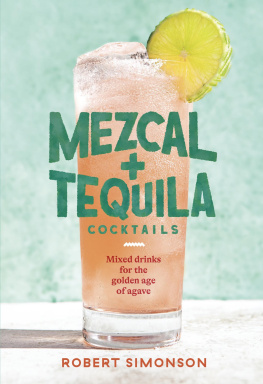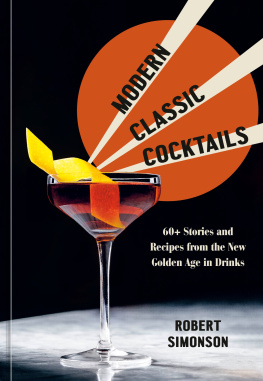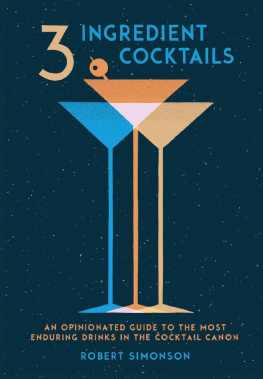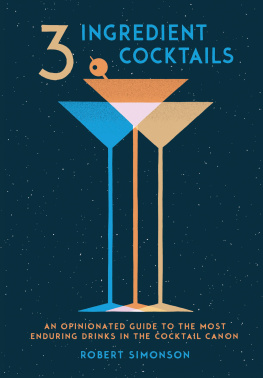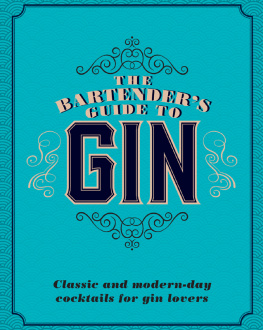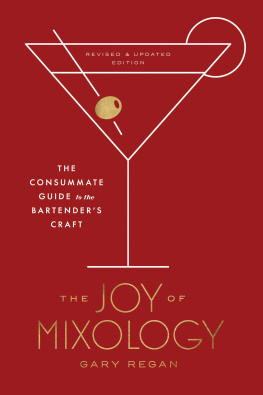Copyright 2016 by Robert Simonson
All rights reserved.
Published in the United States by Ten Speed Press, an imprint of the Crown Publishing Group, a division of Penguin Random House LLC, New York.
www.crownpublishing.com
www.tenspeed.com
Ten Speed Press and the Ten Speed Press colophon are registered trademarks of Penguin Random House LLC.
Portions of the chapter Taking Back Tiki were originally published in different form on Eater.com.
Library of Congress Cataloging-in-Publication Data is on file with the publisher.
Hardcover ISBN9781607747543
Ebook ISBN9781607747550
To the memories of
DICK BRADSELL
(19592016)
and
SASHA PETRASKE
(19732015)
CONTENTS
ALSO BY ROBERT SIMONSON
The Old-Fashioned:
The Story of the Worlds First Classic Cocktail, with Recipes & Lore
PREFACE
I sat at the circular Carousel Bar of the Hotel Monteleone, one of those bars that slowly rotatesin this case counterclockwise, at the rate of four revolutions per hour. With its merry-go-round dcor and absurd mobility, there was perhaps no better introduction to the circus atmosphere of New Orleans French Quarter. It was 11 a.m., but that didnt seem to be stopping the barflies around me. So I ordered a Sazerac. I am compulsive about starting off new experiences correctly, and of all the drinks intrinsic to New Orleans culture, the Sazerac was the name I had heard most often since landing at the Louis Armstrong New Orleans International Airport. And I had never had one.
It was 2006. I wasnt much of a cocktail drinker at that point; more of a wine man. Id order an occasional Gibson or Martini, and I had been known to play around with Gimlets and Tom & Jerrys at home. None of this prepared me for the Sazerac. The drink that was brought to me was startling: weirdly red (the Peychauds bitters, I later learned) and oddly fragrant (the Herbsaint liqueur). It was ice cold and had no garnish. I took a tentative sip.
The edges of my vision suddenly blurred and my focus trained on the glass in front of me. I was simultaneously tasting three things I never had before: rye whiskey, spicy and bright; Herbsaint, as herbal as the name hinted; and Peychauds bitters, whichwell, what the hell were they anyway, and what did they do? But, more importantly, I was tasting them together, along with a bit of sugar and the effects of a lemon twist. It was a seamless, cultivated, elegant whole, and like nothing Id ever experienced before. It was a drink with a story, a past, and more depth than most people I know. The world stopped.
Where had this cocktail been all my life?
The entire week at Tales of the Cocktail was like that. Tales was a cocktail convention. That phrase, cocktail convention, sounded even more silly then than it does now. People had actually gathered from all over the nation to talk seriously about cocktails and mixology. Its founder was a scrappy blonde Southerner about the size of a whippet named Ann Rogers; I had met her by chance at an Illy Espresso pop-up in SoHo in New York, where she was working temporarily as a PR hired gun.
I do this little cocktail thing down in New Orleans, she said. You should come down.
New Orleans was something. I had been writing about wine for a few years. I loved wine and vineyards, but the wine world was a buttoned-up one. The cocktail world, while also dealing in intoxicants, was nothing like that. Hugs. High fives. Hawaiian shirts. Seersucker suits. Two-toned shoes. Hats on every head. Flasks full of wondrous potions, freely shared. Every time I stepped into the lobby of the Monteleone, I was handed a drink by someone. Thanks to tasting rooms, seminars, bars, and other events, I had many drinking opportunities at Tales. I made a list of all the cocktails I drank or sampled that first day. The total was sixteen. In addition to the Sazerac at the Carousel Bar, they included:
Pimms Cup at Napoleon House
Hurricane at Pat OBriens
Milk Punch at Brennans
Champagne Cocktail at Arnauds
Ramos Gin Fizz at Carousel Bar
I sampled six vodkas at a seminar about that spirit and tasted absinthe, a spirit I thought was extinct and legally banned (it was), in a seminar led by absinthe authority Ted Breaux.
I learned to pace myself better the second day.
When I returned, newly converted to the cocktail, I scoured New York City for Sazeracs, my new favorite drink. Ten years earlier, I would have found no bars serving the exotic concoction. In 2006, however, it wasnt difficult. I could get one at a bar called Brooklyn Social, not far from where I lived in Brooklyn. I found a better one at The Good Fork, a restaurant in Red Hook, made by bartender St. John Frizell. I found other Sazeracs at bars in SoHo, Tribeca, and the Lower East Side.
Something was obviously afoot. When I had moved to New York in the late 80s, brew pubs and wine bars were hot. No one, bartender or patron, knew what a Sazerac was. When cocktails were drunk, Cape Codders and Cosmos and Dirty Martinis were the orders of the day. Now, unfamiliar libations like the Martinez, Aviation, and Corpse Reviver No. 2 were being called for. What was going on? A lot, I soon discovered, as, over the next year, I shifted my reportorial focus from wine to spirits and cocktails. It was nothing short of a revolution in the way people made mixed drinks and consumed them. And it wasnt just happening in New York and New Orleans. The world was revisiting the cocktail hour.
ABOUT THE MODERN CLASSICS
AT THE END OF MANY of the following chapters, you will find a cocktail recipe or two. A couple dozen of these are what I have determined to be modern classicsthat is, drinks created during the cocktail renaissance that have been embraced by both bartenders and drinkers, and have shown some staying power. Most of them are served at bars worldwide.
I have tried to be unsentimental and impartial in compiling this list. There are many cocktails I admire that did not make the cut for various reasons: they remain popular, but only in one country or one city; they were ubiquitous for a time, then inexplicably faded from view; or they remained steadily ordered cult classics but never became full-fledged stars. Cocktails that made their mark but are not found herein are the Revolver (Jon Santer), Silver Lining (Joseph Schwartz), Wibble (Dick Bradsell), Russian Spring Punch (Bradsell), Greenpoint (Michael McIlroy), Waylon (Eben Freeman), Death Flip (Chris Hysted), Kentucky Buck (Erick Castro), Gordons Cup (Toby Maloney), Porn Star Martini (Douglas Ankrah), and La Perla (Jacques Bezuidenhaut).
The drinks in the chapters Bringing It All Home and Taking Back Tiki are cocktails from the past that were once obscure or altogether unknown, but have been given new life and popularity through the efforts of cocktail bartenders and historians. Finally, the cocktails found at the back of the book are personal favorites that I feel deserve greater attention.
PROLOGUE
Theres this guy up in the Rainbow Room
IN 1988, DEL PEDRO, an affable Bermudan who had fallen in love with New York, was bartending at Sams, a lavish restaurant inside the Equitable Center in midtown Manhattan. It had been built for $2 million and was owned by actress Mariel Hemingway, who christened it with her nickname. Though not as posh as its neighbors, Le Bernadin and Palio, it was opulent enough. There was a mural by James Rosenquist. Chandeliers hung from the twenty-eight-foot-high ceiling. And standing above Del atop the circular bar was a bronze bison. Sams was certainly a change of environment from Pedros previous bartending gig, a 125th Street dive under the West Side Highway called the 712 Club, where hardworking meatpackers and construction workers also drank hard, and a gun was kept in a drawer. It was there not to keep the patrons in line but to shoot the occasional intruding river rat.


